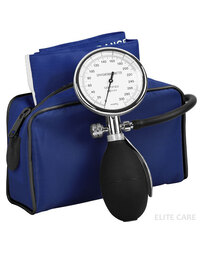Which is more accurate – a digital or aneroid BP device?

The accurate measurement and control of blood pressure (BP) are key elements in the prevention of hypertension, cardiovascular disease and stroke1. Mercury sphygmomanometers—first developed over 100 years ago and largely unchanged since — are used in both hospital and ambulatory settings2. They have been considered the ‘gold standard’ BP measuring devices from which treatment guidelines are developed1.
A routine aspect of nursing practice is obtaining accurate and reliable assessment of patients’ BP in order to ensure optimal and appropriate care and avoid subjecting patients to unnecessary risk3. Traditionally, BP have been measured using a manual Mercury sphygmomanometer, but in recent years the use of automated BP machines such as the Aneroid and Digital sphygmomanometers have been the trend in most hospitals. There are many questions regarding the accuracy and reliability of these machines when used in the clinical setting, and still prefer the manual Mercury columnar sphygmomanometer which is considered the ‘gold standard’ when used by a trained observer2.
There are three common types of blood pressure monitors: mercury, aneroid and oscillometric [digital]. Mercury metres will measure the air pressure in the cuff with a column of mercury. Aneroid devices will measure the air pressure in the cuff with a mechanical contraption rather than mercury. Both metres require a practitioner to listen for pulse sounds using a stethoscope and record the blood pressure readings manually.
Mercury devices are sensitive to temperature and changes in local gravity (e.g. it may require re-calibration if moved to a different altitude). In addition to temperature, aneroid devices are sensitive to mechanical and chemical wear on the components and damages from shocks. The literature seems to agree that aneroid devices need to be calibrated more often than mercury devices.
In a study in British hospital, 3% of the mercury metres and 19% of the aneroid metres used in patient care and judged to be in good working order returned readings that differed by more than 5 mmHg from a calibrated metre.
Then there’s oscillometric devices. They usually measure the air pressure in the cuff with an aneroid mechanism and replace a practitioner’s ear with another mechanical contraption to measure your pulse. All automated digital devices that will return a systolic and diastolic blood pressure reading fall into this category. They may return inaccurate readings for all the same reasons that aneroid devices do, plus their “pulse detection” mechanism may be temperamental.
The accuracy of oscillometric devices was compared to that of mercury devices in clinics in North Carolina and London. Both studies found that the digital devices tended to underestimate blood pressure readings compared to a practitioner using a mercury device, by an average of 3–5 mm Hg.
Several studies have shown that the aneroid device had better accuracy than the digital device as compared to mercury sphygmomanometer and should be used for proper and better management.4
REFERENCES
1. Buchanan S. The Accuracy of Alternatives to Mercury Sphygmomanometers. USA: UIC School of Public Health; 2009 Oct. 4–6p.
2. Turner MJ, van Schaikwyk JM. Automated Sphygmomanometers should not replace manual ones, based on current evidence. Am J Hypertension. 2008; 21(8): 845p.
3. Savage JM, Dillon MJ, Taylor JFN. Clinical evaluation and comparison of the Infrasound, Arteriosonde, and Mercury sphygmomanometer in measurement of blood pressure in children. Arch Dis Child. 1979; 54: 184–9 p.
4. Which is More Accurate in Measuring the Blood Pressure? A Digital or an Aneroid Sphygmomanometer. Shahbabu B, Dasgupta A, Sarkar K, Sahoo SK. J Clin Diagn Res. 2016 Mar;10(3):LC11-4.
The accurate measurement and control of blood pressure (BP) are key elements in the prevention of hypertension, cardiovascular disease and stroke. Mercury sphygmomanometersÑfirst developed over 100 years ago and largely unchanged since Ñ are used in both hospital and ambulatory settings. They have been considered the Ôgold standardÕ BP measuring devices from which treatment guidelines are developed.




